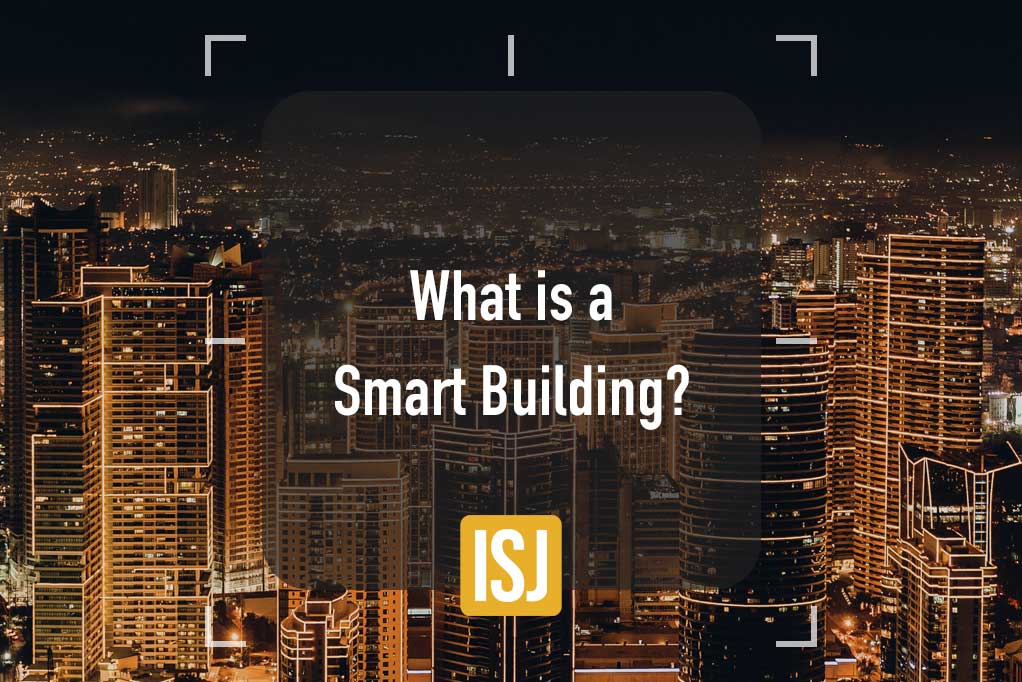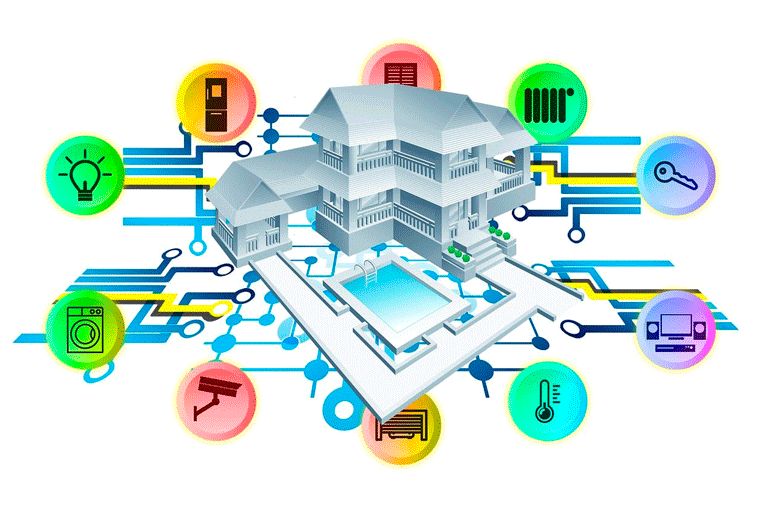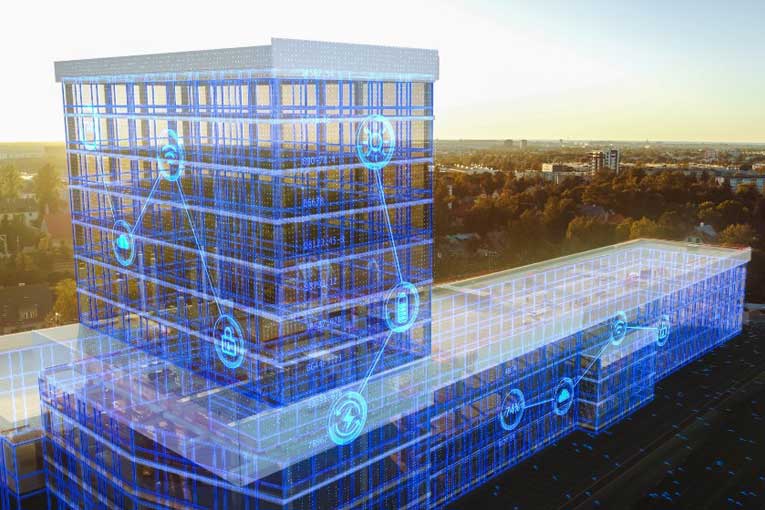What is a Smart Building?


Simon Burge
Share this content
A smart building is a technologically advanced structure that combines various building systems, including HVAC, lighting, alarms, and security, into a single network infrastructure managed by IT.
Smart buildings harness innovative solutions to promote resource efficiency and cost-effectiveness while prioritising occupant safety and comfort.
These buildings utilise a combination of existing technologies and are designed or retrofitted in a manner that allows for seamless integration of future technological advancements.
Key elements commonly found in smart buildings include:
- Internet of Things (IoT) sensors
- building management systems
- artificial intelligence (AI)
- augmented reality.
These mechanisms, along with robotics, are utilised to control and optimise the building’s performance.
In the following chapters, we delve deeper into what smart buildings are and how they’re used in today’s modern world to make living and working in buildings more streamlined, interconnected and efficient.
Article Chapters
ToggleHow Do Smart Buildings Work?

A smart building leverages its intelligence to gather valuable data from user devices, sensors, systems, and services within its premises.
By utilising artificial intelligence (AI) and machine learning (ML), this data is transformed into actionable insights, allowing the building to be programmable and responsive to the requirements of both users and the building manager.
The intelligent network of a smart building also plays a crucial role in ensuring network security.
With the ability to identify and segment devices, the network learns and understands their behavior patterns, thereby enhancing the detection of anomalies and potential intrusions.
This proactive approach strengthens the overall security of the building’s network infrastructure.
What’s Role Does PoE Play in a Smart Building?
The evolution of Power over Ethernet (PoE) from delivering 15W to 90W of power over Ethernet cabling has resulted in a significant expansion in the range of devices that can be powered and connected via PoE.
Utilising PoE to supply power to devices offers several advantages, including increased flexibility in device placement and lower deployment and operational costs compared to using AC power.
In the context of a smart building, PoE plays a vital role in powering and connecting various devices.
These devices encompass a wide array of functionalities, including sensors, lighting systems, HVAC (heating, ventilation, and air conditioning) units, elevators, and fire alarms.
Moreover, PoE can efficiently power USB-C laptops, TV and computer monitors, shades, refrigerators, and room air conditioners within the smart building ecosystem.
By leveraging PoE technology, smart buildings can benefit from simplified installation and reduced dependency on traditional electrical outlets.
The power and data transmission capabilities of PoE enable seamless integration and connectivity, allowing these devices to communicate and interact with each other over a single network infrastructure.
This streamlined approach not only simplifies management and monitoring but also reduces the overall complexity and costs associated with the deployment and operation of devices in the building.
Types of Smart Buildings
Smart Homes

Smart homes are specifically designed to enhance residents’ security and comfort while providing the convenience of remotely controlling various home appliances.
They incorporate automation for home maintenance schedules, energy monitoring, and control of security systems.
At the heart of smart home development lies the concept of assistive technologies, which traditionally referred to aids like wheelchairs aimed at assisting individuals with disabilities in their daily lives.
In the era of the Internet of Things (IoT), the scope of assistive technologies has expanded.
For instance, assistive technologies in smart homes include devices that enable automated scheduling for turning appliances such as lights and washing machines on or off.
Smart medical and health devices are also considered assistive technologies within smart homes, facilitating remote monitoring of elderly or sick residents as well as children.
Wearable sensors in smart homes enable automatic door opening, maintenance of ambient temperature, and monitoring and analysis of energy usage.
In terms of security, smart homes employ sensors that can detect and alert residents of potential gas leaks, water leaks, and security vulnerabilities.
These sensors act as an integral part of the security infrastructure, enhancing safety measures within the home.
By incorporating such assistive technologies and sensors, smart homes offer a comprehensive solution to address security concerns, improve comfort, and optimise energy usage.
With their ability to automate and remotely control various aspects of daily life, smart homes empower residents to create personalised, convenient, and secure living environments.
Smart Offices
A smart office building or commercial complex offers automated and centralised control over various aspects of its operations through an IoT network.
This includes water and electricity management, lighting control, heating and ventilation systems, security measures, parking space management, waste management, elevator operations, emergency exits, access control to computer systems, and garden and equipment maintenance.
In the retail industry, the implementation of IoT sensors in stores enables businesses to collect valuable data such as customer entry times, areas of interest, and purchasing patterns.
This data helps optimise store layouts, maintain appropriate stock levels, monitor staff behavior, improve product tracking (e.g., return rates), measure queue wait times and foot traffic, and facilitate automated checkouts.
Smart commerce solutions contribute to more efficient marketing and product strategies.
Commercial IoT applications are deployed in various settings such as supermarkets, malls, hotels, healthcare facilities, museums, exhibitions, and leisure complexes to enhance the consumer experience beyond the confines of their homes.
These applications involve monitoring and adjusting air quality, lighting, and temperature in public buildings to create a comfortable environment.
They also manage access control and security, monitor retail store inventory, gather data on people’s behavior in public spaces, and provide location services for visitors to hospitality venues.
It’s important to differentiate commercial IoT from consumer IoT, which focuses on personal wearables and smart home devices.
An emerging trend in commercial IoT is edge computing, which enables devices to collect, process, and respond to data locally, close to the source (e.g., foot traffic in a supermarket), without the need for data backhaul to a centralized data center.
Communication in commercial IoT solutions utilises various connectivity types, including Bluetooth, Wi-Fi, LoRa, 4G LTE, and ZigBee, depending on the specific application requirements.
Smart Workplaces

Smart workplaces are equipped with advanced hardware and software solutions to enhance communication and collaboration, with features like video conferencing systems.
These intelligent environments utilise sensors to track and manage business assets, such as company laptops, ensuring their proper monitoring and security.
One of the key benefits of smart workplaces is the automation of tasks and processes.
For example, IT security vulnerabilities can be automatically monitored, and remote management of off-site employees and contractors becomes streamlined.
Mundane tasks like scheduling conference rooms or arranging catering for meetings can be efficiently handled remotely or through digital business assistants.
Smart workplaces also leverage technology to provide seamless onboarding experiences for new employees.
Through push notifications, newcomers can receive helpful information and guidance within their new office environment.
This can include notifications about their current location within the building or the necessary security clearance to access specific offices or corporate spaces.
The integration of smart systems in workplaces ensures a smooth and efficient operation.
From vending machine availability to well-maintained toilets and convenient parking options for visitors, these intelligent environments prioritise user comfort and convenience.
By leveraging technology and automation, smart workplaces aim to create an optimal working environment for employees and visitors alike.
Smart Factories & Warehouses
In industrial settings, smart factories and warehouses are effectively managed through the utilisation of industrial IoT (IIoT) networks.
The IIoT encompasses interconnected smart factories, warehouses, supply chains, logistics systems, and industrial machinery, culminating in a comprehensive smart industrial ecosystem.
A prominent illustration of smart building management in the industrial sphere is the integration of robots within factories and warehouses.
This application of robotics in the smart industry is often referred to as the Internet of Robotic Things (IoRT).
Key Uses of Smart Buildings
Automation
At the heart of a smart building lies its interconnectedness.
The fundamental characteristic of a smart building is the seamless integration of its core systems.
By linking together advanced technologies like real-time IoT occupancy sensors and building management systems, valuable information can be shared and utilised to automate a range of processes.
This includes but is not limited to functions such as heating, ventilation, lighting, air conditioning, and security.
The true essence of a smart building lies in its ability to facilitate communication and interaction among its internal systems.
This interconnectedness is what defines a building as “smart” – the capacity of its systems to effectively communicate and collaborate with one another.
Integration with Other Buildings
The synergy achieved by sharing and integrating data among building systems elevates the overall value of a smart building beyond the individual components.
By integrating IoT occupancy sensor data into a desk or room booking system, organisations can streamline management processes and create a smart environment for employees.
This integration allows for efficient utilisation of assets by providing real-time information on their availability, bookings, or occupancy status.
As a result, employees benefit from a seamless and intelligent workspace that optimises resource allocation and enhances productivity.
Spacial Optimisation
Managing space utilisation effectively is vital for businesses as buildings and real estate often rank as the second-highest cost after wages and employees.
To achieve optimal usage, smart buildings rely on the integration of sensors that play a crucial role in collecting data for informed decision-making regarding resource allocation.
By incorporating occupancy sensors within the building infrastructure, valuable insights can be derived concerning resource allocation.
For instance, these sensors provide data on occupancy levels, enabling businesses to assess whether their facilities adequately meet their staff’s requirements.
The analysis of occupancy patterns can help identify several key factors, including:
- Evaluating the adequacy of meeting rooms in terms of size and quantity.
- Understanding the popularity or lack thereof of communal areas.
- Assessing the sufficiency of the provided working spaces.
By leveraging occupancy data and analytics, businesses can make informed decisions to enhance space utilisation and ensure alignment with the needs of their workforce.
This data-driven approach improves efficiency, maximises the value of available resources, and contributes to a more productive and adaptable work environment.
Reduce Maintenance
Employing artificial intelligence (AI) enables you to detect maintenance needs for assets by learning and recognising abnormal usage patterns, notifying you when such patterns are identified.
Through the collection of precise data from devices like people sensors, you gain a more accurate understanding of the frequency with which specific facilities within your building are utilised.
This empowers you to adopt a proactive approach to managing maintenance, cleaning, restocking, and overall wear and tear, thereby extending the lifespan of equipment, furnishings, and appliances.
By leveraging AI-driven insights, you can effectively optimise resource allocation, minimize downtime, and ensure the efficient operation of your building’s assets.
Benefits of Smart Buildings
Smart buildings produce a substantial amount of invaluable data concerning their usage patterns.
By analysing this data, you can gain insights into trends and patterns, empowering you to make informed decisions on how to enhance the efficiency of your building.
This process offers several advantages:
Increased Productivity
Creating a space that promotes good indoor air quality, physical comfort, security, cleanliness, effective lighting, efficient processes, and adequate room for staff is crucial in enabling optimal staff performance.
To achieve this, it’s essential to identify and understand how people navigate and utilise the building.
This knowledge is integral to improving the physical layout, optimisng frequently visited areas, and minimising waste.
For instance, expanding cramped high-footfall spaces would be a practical step towards this goal.
In the realm of smart buildings, the focus extends beyond cost reduction and energy efficiency.
It becomes imperative to operate intelligently for the benefit of your staff.
Implementing intelligent systems such as meeting room and desk booking can help minimise wasted staff time and enhance the overall intelligence of your space.
Reduced Operational Costs
An intelligent building has the capability to utilise collected data to optimise its operations.
For instance, it can dynamically adjust shades to maximize natural light, reducing the need for electric lighting.
This effective lighting management has demonstrated significant reductions in power consumption, aiding buildings in achieving higher energy efficiency and meeting rigorous regulations concerning greenhouse gas emissions.
Furthermore, the data gathered by smart buildings can facilitate automated scheduling processes, ranging from the allocation of parking spaces to workspace assignments and conference room reservations.
By leveraging this data-driven approach, buildings can streamline and optimise resource allocation, enhancing overall efficiency and maximizing the utilisation of available spaces and facilities.
Reduced Energy Consumption
Smart buildings offer the opportunity to enhance energy efficiency and subsequently reduce energy costs.
By integrating Internet of Things (IoT) sensors that monitor occupancy with your building management system, you can automate the process of turning off lights and HVAC systems in unoccupied rooms or spaces.
This proactive approach eliminates the unnecessary consumption of energy associated with these aspects.
By effectively managing and optimising energy usage based on real-time occupancy data, smart buildings contribute to significant energy savings and promote sustainability.
Flexibility
The data collected from smart buildings can be utilised to identify changes in occupancy density.
This information enables the building’s HVAC systems to dynamically adjust airflow, humidity, and temperature accordingly, ensuring optimal comfort and energy efficiency.
Additionally, smart-building data can be leveraged to implement intelligent lighting systems.
By setting escalating density thresholds, the color of lighting can be modified to indicate overcrowding in areas such as conference rooms, workspaces, or the overall building.
This visual cue serves as a helpful indicator for occupants and facilities managers to take necessary action, such as finding alternative spaces or implementing crowd management measures.
Smart Building Drawbacks
Implementing employee tracking and monitoring systems in workplaces raises concerns regarding privacy and data management, which often require legal guidance to address appropriately.
The adoption of smart buildings often necessitates significant capital investment in advanced technologies such as Building Management Systems (BMS) or Building Automation Systems (BAS).
These systems serve as digital hubs, facilitating the management of devices and applications that control various aspects of the building’s operations.
While smart technologies offer numerous benefits, some individuals may find them intimidating, particularly when faced with issues like malfunctioning sensors or perplexing error messages from interconnected devices.
In such cases, user support and troubleshooting measures become crucial to ensure a positive experience and user acceptance.
It’s important to note that smart buildings heavily rely on reliable and persistent internet connections.
A stable and uninterrupted internet connection is essential for the seamless functioning of connected devices and the continuous flow of data within the smart building ecosystem.
How to Make a Building Smart
To effectively convert your premises into a smart building, it’s crucial to recognise the importance of accurate and reliable data.
The foundation of smart building technology lies in the availability of precise data that captures the utilisation of the facility.
The initial step towards acquiring and analysing this data involves implementing smart building solutions, such as occupancy sensors.
These sensors enable the recording of valuable utilisation information, serving as a starting point for data-driven insights.
Once you have access to this information, you can identify areas for improvement by leveraging integration with other smart technologies and building systems, enabling automation and enhancing operational efficiency.
Additionally, this data empowers strategic decision-making processes.
Conclusion
In summary, adopting smart building technology offers great potential for improving efficiency, enhancing occupant experiences, and maximizing resource usage.
By leveraging accurate data collected from sensors and integrating various intelligent systems, building owners and managers can make informed decisions, automate processes, and create a sustainable and comfortable environment.
From effective energy management to optimising space utilisation, the advantages of smart buildings are clear.
As technology continues to advance, it’s essential for organisations to embrace the opportunities provided by smart buildings and fully harness their capabilities in shaping the future of our built environment.


